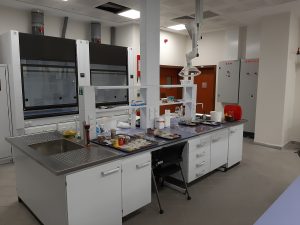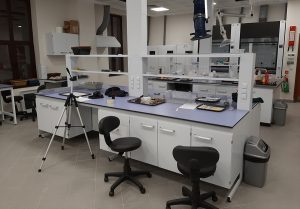Resources for Students and Researchers
Degrees with the Department of Archaeology and History of Art
KUDAR is closely affiliated with the Department of Archaeology and History of Art (ARHA) in the College of Social Sciences and Humanities at Koç University. In addition to Matthew Harpster and Michael Jones, both full-time faculty in ARHA, KUDAR offers full-time stipends to eligible MA and PhD students enrolled in ARHA. The center’s Conservation and Documentation laboratory has a specialized environment to train students and support research projects, while our growing library builds upon the general collection of Archaeology, Art History, and related disciplines, housed in the Suna Kıraç Library on the main campus of Koç University. Students also have the opportunity to participate in our field projects in Italy and Türkiye; our new collaborative three -year agreement (2020-2023) with the Institut National du Patrimoine of Tunisia means students can now gain field experience in Tunisia as well.
Students are able to pursue either an MA or a PhD with a specialty in Maritime Archaeology. Individuals deciding to pursue this option are expected to complete successfully a combination of general requirements for all ARHA students, as well as a selection of electives focusing on maritime topics. In addition to the courses listed below, future courses will focus on Mediterranean Maritime Archaeology. All students pursuing this specialty are expected to complete a research thesis for their MA or PhD degree – this project may incorporate data collected from fieldwork, original archival research, or experiments conducted in the center’s conservation laboratory.
Individuals planning on applying to ARHA for enrollment as an MA or PhD student for the Maritime Archaeology speciality should contact Burcu Ergin (burcuergin@ku.edu.tr) for the departmental eligibility requirements and application procedures. In addition, we strongly recommend that applicants for the Maritime Archaeology speciality have a clear research program to present in their application materials.
Introduction to Maritime Archaeology
The practice of archaeology with a focus on maritime-related social practices has become a very distinct branch of the broader field of archaeology. As it employs a number of specialized skills, methodologies and theories, this course is designed to introduce postgraduate students to the discipline. It will provide them with an overview of the field, research questions integral to the topic, significant excavations, key individuals, key issues in the management and protection of underwater cultural heritage (UCH), and experience generating a project proposal and management scheme.
Documentation and Conservation Methods
Despite predominantly working under water, many of the methods and techniques used by maritime archaeologists are adaptations of approaches applied by their colleagues on land. In addition, both terrestrial-and maritime-based projects utilize a similar range of conservation methods and concepts and must plan for the proper storage and conservation of recovered archaeological remains. Valuable to both terrestrial and maritime archaeological students, then, this course is an introduction to the tools and methods applicable on land and under water for the investigation of pre-modern archaeological sites. Students will learn and practice methods used in site and artifact documentation and basic conservation techniques.
Themes in Maritime Archaeology
Similar to the field of archaeology in general, maritime archaeology also has a collection of sub-specialties, each of which contain their own research agendas and intellectual history. Over the term, this course will focus on three of these sub-specialties: Maritime Cultural Heritage, Maritime Landscapes, and the History of Shipbuilding. These three themes are important because they contain questions and issues unique to maritime archaeology, yet compliment courses and themes present within archaeology as a whole. For example, how can we apply the notions of ‘ownership’ or a ‘state or nation of origin’ to a wreck assemblage? Is a shipwreck ‘moveable’ or ‘immoveable’ heritage? Is ‘maritime’ a flexible cultural or social construct, and where might the maritime elements of a community begin and end? How might it be expressed or manifested in the material record? Or, what can the conception, design, and construction of ships tell us about the individuals and communities that built them? How might changes in method or technology reflect changes in society as a whole? The goal of this course is to demonstrate to the student that maritime archaeology encounters and incorporates the broad questions and issues woven through archaeology, yet integrates and engages them in ways unique to the material culture we investigate.
Mediterranean Seafaring from the Bronze Age to the Roman Empire
This course is an introduction to the archaeology of Mediterranean seafaring from the Old Kingdom period in Egypt (c. 2700 BC) to the height of the Roman Empire in the second and third century A.D. We will discuss the maritime activity of a number of ancient cultures, including the Egyptians, Minoans, Phoenicians and Carthaginians, Greeks, Etruscans, and peoples of the Roman Empire. Topics to be discussed will include the development of Mediterranean seafaring technology and long-distance trade networks, ancient port cities and coastal communities, naval warfare and piracy, and the political, economic, and cultural effects of the movement of individuals and populations along Mediterranean sailing routes.
Conservation and Documentation Laboratory

The KUDAR Maritime Archaeology Laboratory was founded in 2018 as a space for teaching and research in maritime archaeology at Koç University. Because most artifacts removed from marine or waterlogged contexts will require some form of conservation treatment, whether it is the removal of soluble salts and concretion from pottery and metal objects or the consolidation of delicate organic materials, a laboratory space is essential for any artifact-based maritime archaeology research. The Department of Archaeology and History of Art at Koç University currently offers a graduate-level Documentation and Conservation Methods course (ARHA 582) in the KUDAR Laboratory, which provides an introduction to methods for documenting and conserving archaeological materials; the course includes hands-on experience with different techniques and the opportunity to develop final projects related to student interests and research.
In addition to its conservation facilities, the laboratory’s facilities support a variety of other training opportunities. In addition to photographic, digital, and manual documentation of artifacts, and 3D photogrammetry, the lab can also support the documentation, conservation, and analysis of archaeological material by ARHA faculty and students as well as research fellows pursuing projects in maritime archaeology or related fields.
The laboratory includes two fume hoods, sinks, a compressed air line and pneumatic chisels (a necessity for concreted pottery and metal objects from underwater sites), a Telstar Lyoquest freeze dryer for conservation treatments of organic materials, an ICP-OES (Internally Coupled Plasma Optical Emission Spectrometry) device for elemental analyses, cameras and photography lights and accessories, and a variety of tools and supplies for artifact documentation and conservation. Equipment for off-campus field- and museum-based projects are kept in the laboratory storeroom, including diving and photography equipment and computers for 3-D photogrammetry modeling and other research applications. The KUDAR Maritime Archaeology Laboratory also provides resources for KUDAR projects in Türkiye.

